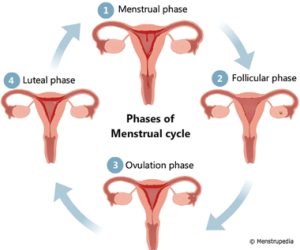Webster’s Dictionary defines a menstrual cycle as “the cycle of physiological changes from the beginning of one menstrual period to the beginning of the next.” (1) The average length of a woman’s cycle is 28 days, but this can vary from woman to woman and even cycle to cycle. (2) During these 28 days, four different phases occur; menstruation, the follicular phase, ovulation, and the luteal phase. Throughout this blog post, I will summarize hormonal changes occurring in the body during each phase, symptoms that may occur, and how tracking your cycle can be used to prevent and plan a pregnancy.
The Phases

Menstruation
Day 1 of your menstrual cycle is the first day of your period. To prepare for pregnancy, the lining of the uterus (the endometrium) thickens. A period occurs when a pregnancy does not. In the absence of pregnancy, hormones estrogen and progesterone drop and the uterus sheds the thickened lining which passes through the vagina. (4) The average length of this phase is 3-7 days. (3) Symptoms you may experience are:
- Cramps
- Bloating
- Breast tenderness
- Moodiness
- Lower back pain
Follicular Phase
The follicular phase begins on the first day of menstruation and ends at ovulation. During this phase, a hormone called follicle-stimulating hormone [FSH] is released and stimulates the ovaries to create follicles [also known as corpus luteum]. (3) Follicles are where immature eggs are housed. Throughout the phase, one of the eggs will mature and estrogen will surge, causing the lining of the uterus to thicken and prepare for pregnancy. The average length of the follicular phase is 13-14 days. (3)
Ovulation
Ovulation occurs when a mature egg is released from an ovary and descends through the fallopian tube towards the uterus. (4) This phase starts when a hormone called luteinizing hormone is released in response to the high estrogen during the follicular phase. It usually happens around day 14 of your cycle [or two weeks before day 1 of your next cycle] and lasts only 24 hours. Symptoms you may experience are:
- Cramping
- Rise in basal body temperature
- Vaginal discharge [egg white consistency]
Luteal Phase
During this phase, the corpus lutetium releases progesterone and estrogen. These hormones cause the endometrium to continue to thicken, preparing the uterus for a fertilized egg. After fertilization and if the egg is implanted into the uterine wall, a hormone called human chorionic gonadotropin [hCG] is produced. HCG will maintain the thickened endometrium to sustain the pregnancy. If an egg is not fertilized, the endometrium will shed the extra layers and the next period will begin. The length of this phase is 11-17 days.
The Fertile Window
So, how can tracking your cycle indicate when you are fertile? Well, we know that ovulation typically happens around day 14 of a cycle, so if you know how long your cycles are you can probably determine when you are ovulating. Knowing when you are ovulating can advise you on when to abstain from sexual intercourse or when to increase the frequency of it. This will depend on your pregnancy goals. If you are wanting to plan a pregnancy, the “fertile window” is the time to engage in intercourse. If you are trying to avoid pregnancy, this is the time to abstain.
Along with documenting when your period begins and ends each month, tracking your basal body temperature is helpful. Right before ovulation, there is a dip in temperature. Then right after, the temperature increases and stays up for a few days. (6) You can do this by checking your temperature upon waking each morning, before getting out of bed. The longer you do this, the more familiar you will become with your cycle and the symptoms that are occurring in each phase.
There are different methods of tracking your cycle, but my personal favorite is using an app on my phone. The benefits of an app are daily reminders to check temperature/document data, a personalized algorithm created to help predict ovulation and periods, extra education, and trends from past cycles. You can find a list and breakdown of different apps here.
It’s important to remember that patterns vary from woman to woman and cycle to cycle. Tracking your cycle can give you significant information and help you better understand your body.

Take Aways
- The menstrual cycle is made of 4 phases: menstruation, follicular phase, ovulation, and the luteal phase.
- Different hormones are elevated throughout each phase which can cause different symptoms
- Ovulation lasts around 24 hours. Meaning this is the only time a pregnancy can be conceived.
- Tracking your cycle can help you prevent and/or plan a pregnancy.
- Not all cycles are the same.
If you have any questions or concerns, please contact;
Nurturing Center of Lubbock
3303 66th Street
Lubbock, TX 79413
Phone: 806-780-6853 (available 24 hours)
Text: 806-317-4480
Email: info@nurturinglife.org
Sources
(1) https://www.merriam-webster.com/dictionary/menstrual%20cycle
(3) https://www.betterhealth.vic.gov.au/health/conditionsandtreatments/menstrual-cycle
(4) https://www.healthline.com/health/womens-health/stages-of-menstrual-cycle#menstrual
(7) https://www.menstrupedia.com/articles/physiology/cycle-phases
(8) https://www.freepik.com/free-photos-vectors/uterus-cartoon/8
(9) https://angea.com.au/the-4-keys-to-finding-your-fertility-window/
Marlee Henn, RN
Marlee has been a nurse for two years and currently works in a functional medical clinic and part time in a long term acute care center. She has a passion for natural living, women’s health, and education.

Recent Comments